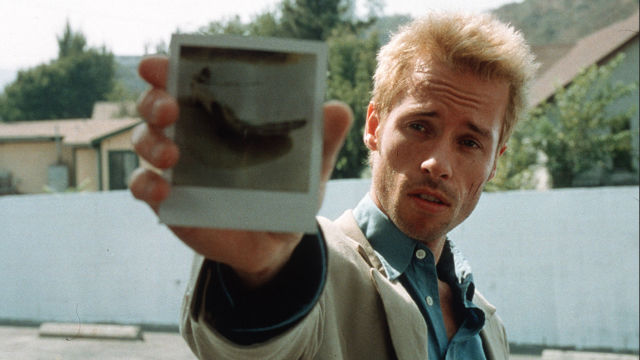Movie Review: Memento (2000)
“Some memories are best forgotten”


Memento (2000)
Director: Christopher Nolan
Cast: Guy Pearce, Carrie-Anne Moss, Joe Pantoliano
Synopsis: A man creates a strange system to help him remember things; so he can hunt for the murderer of his wife without his short-term memory loss being an obstacle.
Structure is everything in Christopher Nolan’s mind-bending thriller, Memento. If you were to watch its complex plot unfold in chronological order you would probably consider it a rather ordinary film, devoid of suspense or surprise, but when told as close as cinematically possible from the viewpoint of its protagonist, it’s simple plot is transformed into a labyrinthine puzzle which demands complete attention from its audience and repeated reappraisal of everything we think we know. The story is mostly told in reverse chronological order – it begins at the end and ends at the beginning, like Ouroboros devouring its own tail – although events depicted in the black-and-white scenes occur before any of the scenes between which they are sandwiched, and move forward until they connect with the rest of the movie, like a car driving towards another car that’s reversing toward it. It’s disorienting to begin with, but it’s surprising how quickly we grow accustomed.
Guy Pearce (In Her Skin, 33 Postcards) sports a blonde dye job and two vertical scars on his cheek as Leonard Shelby, a man who lacks the ability to form new memories after receiving a blow to the head. He can remember everything about his life before the blow, but nothing that happens since remains in his memory for more than a few minutes at most. That’s why, although he’s been living in a cheap motel for a few days, he still tries to push open its front door instead of pulling it, and puts Burt (Mark Boone Junior – 2 Fast 2 Furious, Batman Begins), the motel’s amiable doorman, through the same explanatory speech each time they meet. Shelby’s condition leaves him extremely vulnerable. As amiable as Burt might be, he openly confesses to charging Shelby for two rooms, knowing that his guest will forget his confession within minutes.
Shelby does have a number of tactics for managing his condition, though. He writes notes on snapshots he takes of the people and places he considers might be important. And his body is a tapestry of cryptic tattoos. One, strung upside down like a chain across his upper chest reads “he raped and murdered my wife.” Another, smaller, but just as important, is situated between the thumb and finger of his left hand and reads “Remember Sammy Jankis.”
Shelby’s injury was sustained as he tried to defend his wife from two attackers, one of whom he managed to shoot dead before the second delivered the debilitating blow. The police refuse to believe there even was a second attacker, so now Shelby’s on a mission to find and kill the man who destroyed his life. It would be a daunting task for anyone, but for somebody with Shelby’s condition it would seem impossible, and we have to wonder why he doesn’t enlist the aid of an able-minded friend or private detective to assist him in his quest. Two people Shelby recognises from their snapshots keep re-appearing in his life: the fast-talking Teddy (Joe Pantoliano – Bound, The Matrix) insists he’s Shelby’s friend. He might be a snitch or he might be an undercover cop. His story keeps changing, and on the bottom of Shelby’s photo of Teddy is a warning not to believe his lies. Teddy’s dead when we first meet him, a fading image on a snapshot in a clever opening scene played in reverse, but that doesn’t prevent Memento from devising a maze-like puzzle from the events leading up to his death. The other person is Natalie (Carrie-Anne Moss – The Matrix), a weary-looking barmaid whose attitude towards Shelby changes each time they meet – although he, of course, doesn’t realise it. They are friendly in the opening scenes – but is she to be trusted? Shelby’s never sure and nor are we, and this uncertainty extends even to an ending which solves the puzzle without really providing any closure.
It would be easy for Memento’s plot structure to come across as gimmicky trickery designed to bedazzle the viewer into believing they’re witnessing something more substantial than they actually are, but the structure adds a new and intriguing dimension to a relatively straightforward tale while retaining an internal logic – even if there is a visible crack here and there that’s never explained away. The plot’s deliberate ambiguity is something of a problem – the reveal is provided by a character we know to be a liar, and no compelling reason is given to believe he’s now telling the truth. But many people like ambiguity in their movies. It allows them to dream up all manner of daft theories, and fuels endless inconclusive debate on the internet. A lesser filmmaker might have been tempted to make a sequel to Memento – there’s still a story to tell, after all, and the ending opens up options that were never available until the final reveal – but the story, like Shelby himself, can only follow a downward spiral once the credits roll, and, anyway, all intrigue is spent by its end. Thankfully, Christopher Nolan had more integrity than to return to Leonard Shelby’s tortured world.
(Reviewed 13th April 2016)
Click below for a free preview of the Kindle book, The Films of Christopher Nolan. The book, written by the author of this review, features reviews of all of the actor’s films, and is available to buy, or to read for free if you’re a member of Kindle Unlimited. You don’t need a Kindle reader – Amazon’s Kindle app works on most popular devices and can be downloaded for free from their site.
httpv://www.youtube.com/watch?v=UFuFFdK7i44
